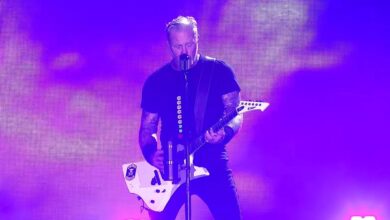When Metal Crashed Into Pop: Lady Gaga and Metallica’s Explosive Grammy Fusion
Some performances ignite the atmosphere, others linger in memory—but every so often, one reshapes the landscape of live music entirely. During the 59th Annual Grammy Awards, audiences witnessed such a moment: a meeting of two seemingly distant worlds, rock and pop, merging in a way that stunned millions. In 2017, under the blinding lights of the Staples Center, Metallica’s James Hetfield and global pop phenomenon Lady Gaga unleashed a fiery rendition of “Moth Into Flame.” The room pulsed with anticipation, and what unfolded was nothing short of electric.
Before that night, the thought of Metallica—the defining force of heavy metal—sharing the stage with Lady Gaga, known for her theatrical pop dominance, seemed like a daring gamble. Yet, once the stage went dark and the first chords roared through the arena, any doubts vanished. This wasn’t a clash of styles—it was a union of raw artistry. Each note and movement proved that both acts thrived on intensity, passion, and a fearless drive to captivate.
As the opening riff thundered out, Gaga stormed onto the stage in black leather and spikes, radiating command. There was no trace of hesitation—only grit and defiance. Her movements exuded the confidence of an artist born to perform, while Hetfield embodied the essence of rock’s rebellious heart. With every beat, the boundaries between pop spectacle and metal ferocity began to dissolve, creating a shared world of rhythm and rage.
Then came the unexpected: Hetfield’s microphone failed in the opening verse. For a tense moment, the world’s biggest rock frontman was rendered silent on live television. But before chaos could take hold, Gaga reacted instinctively. She leaned toward Hetfield, offering her mic without missing a beat. Their voices intertwined, amplifying the energy in the room rather than diminishing it. The glitch, instead of derailing the performance, became the spark that transformed it into legend.
The failure of technology became a triumph of chemistry. Gaga’s powerhouse vocals surged through the mix, her delivery bursting with ferocity that rivaled any metal frontliner. Her intensity matched the band’s at every turn—each scream, each gesture, echoing the unrelenting pace of the guitars and drums. The pop icon became a conduit for the same raw energy that defined Metallica, bridging two genres that few imagined could coexist so seamlessly.
Hetfield, visibly frustrated for a fleeting instant, turned his irritation into sheer power. Fueled by adrenaline, he ripped through his guitar parts with renewed aggression, his stance low and unwavering. When his mic finally roared back to life, he unleashed a torrent of vocals that shook the room. The audience, initially anxious about the malfunction, was now witnessing something transcendent—the collision of two artists feeding off chaos to deliver greatness.
With flames bursting behind them and lights flashing across the arena, the stage felt like an inferno. Lars Ulrich drove the rhythm with volcanic precision, every drum hit echoing like thunder. Kirk Hammett’s solo sliced through the tension, igniting the crowd even further. Amid the madness, Gaga didn’t just perform beside the band—she moved with them, embodying the same headbanging, defiant energy that has long defined Metallica’s legacy.
When the last notes faded, the crowd erupted. Critics hailed the performance as a revelation, celebrating not only its boldness but its cultural impact. It wasn’t a fleeting stunt—it was the dismantling of musical borders. Metal fans embraced Gaga’s fearlessness, while her followers discovered the raw might of heavy metal. For that brief, explosive night, pop and metal weren’t separate—they were united by pure, unfiltered passion.
Behind closed doors, both Hetfield and Gaga later admitted their frustration at the malfunction, yet they also recognized how the mishap had elevated the performance. It became a tale of improvisation and instinct, of two consummate artists refusing to let technology dictate art. The moment turned from an error into an emblem of perseverance, symbolizing how true performers can transform flaws into unforgettable highlights.
Online, the reaction was instantaneous. Photos of Gaga and Hetfield sharing the mic went viral across every platform. Fans rewatched the clip endlessly, creating remixes, memes, and edits celebrating their synergy. Conversations about what a full collaborative record between the two might sound like flooded social media. Within days, the performance had transcended its Grammy origins to become a cultural moment shared by millions around the globe.
In the months that followed, Gaga reflected on how performing with Metallica had reshaped her perspective. She described it as one of the most exhilarating experiences of her life—a night that reminded her that energy, authenticity, and courage transcend labels. For her, it was proof that music’s greatest strength lies in its ability to unite hearts that beat to different rhythms.
Metallica, always eager to evolve, embraced the unexpected aftermath. Their partnership with Gaga drew in legions of new fans—listeners who may never have ventured into metal’s realm before that night. It reminded the world why the band remains one of music’s most daring forces, forever unafraid to challenge expectations and redefine what a live show can be.
Even years later, that Grammy performance continues to stand as a defining moment in live television. It’s remembered not just for its pyrotechnics and energy but for the unfiltered humanity at its core. Two artists from opposite ends of the musical spectrum met in the middle, refused to back down, and delivered something that felt entirely spontaneous yet perfectly destined.
Ultimately, that night embodied everything that makes live music so powerful: risk, chaos, and emotion. When Gaga and Metallica shared that stage, they shattered genre barriers and reminded everyone watching that true artistry thrives in unpredictability. What began as a technical failure evolved into a triumph of spirit—and the memory of that defiant, electrifying performance continues to burn brightly in music history.





